Choosing the most suitable programming language for your software is always challenging, whether you’re working on an entirely new project or creating new functionality to enhance an existing product. To ensure you make the best choice, you need to consider various factors including project specifics and time and budget limitations. You should also consult with technical specialists.
Although there’s no silver bullet for all types of software, you might have heard that using Python is a sure way to kick off product development. Python is a common choice for software development because this programming language often makes it fast and relatively easy to build a prototype, integrate third-party services, ensure product scalability, and more.
In this article, we discuss the key benefits of the Python programming language and take a look at five top companies using Python to deliver their software: Dropbox, Spotify, Netflix, Facebook, and Uber. This article will be helpful for product owners and development leaders who want to learn about possible ways to enhance and speed up their projects.
Contents:
Why businesses use Python to build and enhance their products
According to the TIOBE Index, Python was the most popular programming language in the first three quarters of 2022, followed by Java, C, and C++. Such interest in Python is not surprising considering its benefits.
Python is a high-level interpreted programming language that ensures high code readability. Engineers use this language in various types of software and for various purposes. For example, Python often comes in handy when:
- Developing data analysis, machine learning, and blockchain solutions
- Automating tasks and testing software
- Building web applications
- Working on software prototyping
- Developing microservices and handling DevOps processes
The main reasons for Python’s popularity among developers are:
- Simple syntax
- Fast development speed
- Open-source nature
- Portability
- Existence of numerous libraries and tools
- Compatibility with other languages
- Rich integration capabilities
Thanks to these qualities, Python helps development teams to:
- Quickly and efficiently deliver product prototypes
- Reduce the amount of code
- Ensure cross-platform capabilities
- Easily integrate various third-party modules
However, you might notice that some projects either use Python as a supplementary programming language or don’t even include it in the technology stack. Depending on the requirements and specifics of your software, it might make sense to go with another language such as Java, C, or C++.
Certain Python limitations commonly lead companies to reduce the use of Python or avoid it altogether. For example, Python is considered slower than C/C++ and Java and has higher RAM consumption compared to C/C++. Development areas where Python is rarely used include:
- Embedded software
- Low-level development (drivers, file systems, etc.)
- Desktop applications
- Mobile applications
Still, Python has been used to build many popular platforms, proving its value. Let’s explore five famous companies that use Python and what issues they’ve managed to resolve thanks to this programming language.

1. Dropbox
Dropbox is a cloud service for storing, synchronizing, and sharing files. Users can access Dropbox via various devices, as it has desktop, mobile, and web applications. In 2021, Dropbox reported 16.79 million paying users, with an increase of over one million paying users since 2020.
Since Dropbox is a large and ever-growing project, the company uses several programming languages and from time to time introduces significant changes to their infrastructure to keep up with increasing demand and ensure a positive user experience. Currently, Dropbox relies on languages including Python, Go, TypeScript, and Rust.
In the early days, Dropbox was so determined to make the most out of Python that they even hired the creator of Python, Guido van Rossum, away from Google in 2012. Drew Houston, a co-founder of Dropbox, has said that Python became his favorite language due to its simplicity, flexibility, and elegance.
How does Dropbox leverage Python?
Originally, Dropbox developers wrote both server and desktop client software in Python. The cloud storage platform also uses lots of third-party open-source libraries written in Python.
The primary reason for choosing this language was the development speed it offers thanks to the convenient coding process, a vast variety of helpful Python tools, and integration capabilities. These benefits were crucial to Dropbox’s early and rapid scaling as well as for implementing, testing, and deploying new features. Also, Python was critical for ensuring cross-platform support, as it allows you to write code once and then use it on different platforms.
From 2015 to 2018, Dropbox moved from Python 2 to Python 3, which turned out to be one of the largest Python 3 migrations ever. This version of Python brought exciting new features including type annotation syntax and coroutine function syntax that helped developers:
- Improve their work with large codebases
- Write cleaner code
- More easily analyze and debug code
By 2019, Dropbox was famous for having deployed more than four million lines of Python code.
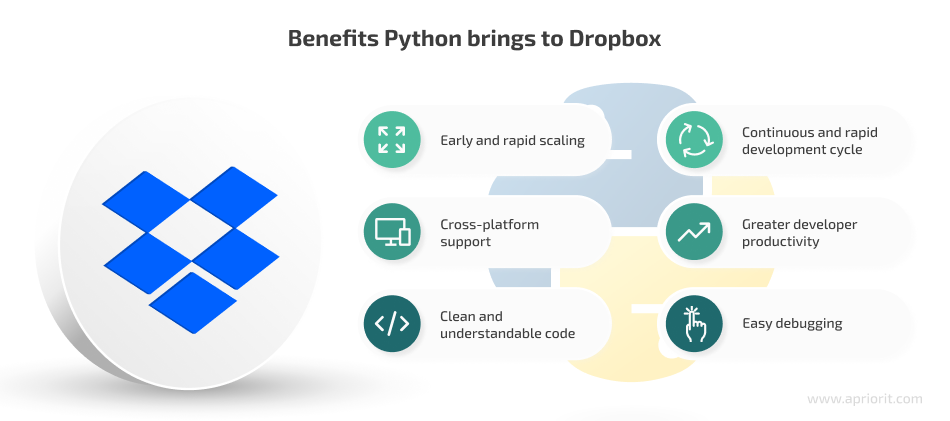
2. Spotify
Spotify is a digital music, podcast, and video streaming service providing access to millions of songs and other content from creators all over the world. Its main functions are playing music, providing recommendations based on user preferences, and building collections of music and podcasts.
Users can access Spotify from various devices including computers, smartphones, tablets, TVs, and vehicle infotainment systems. Spotify applications are available for Android, iOS, Windows, Linux, and macOS. Such convenience and a variety of features have made Spotify the most popular service provider in the music subscription market, with a 31% market share at the end of Q2 2021.
As a complex cross-platform solution, Spotify is written in several programming languages, including Java, C++, and Objective-C. However, the first and most used language has always been Python.
How does Spotify leverage Python?
Python is used by Spotify in the back end and for data analysis:
- The back end consists of many interdependent services, around 80% of which are written in Python. This programming language has helped Spotify ensure a satisfactory development speed.
- Data analysis at Spotify is based on Luigi, a Python package that helps to prototype complex data jobs. Spotify applies Luigi together with machine learning (ML) algorithms in the Radio, Discover, and Recommendations features.
Thanks to Python, Spotify has also managed to prototype services, quickly write scripts, and set up build processes. Apart from that, Spotify uses the Python-Graphwalker tool to perform model-based testing of user-facing clients and APIs.
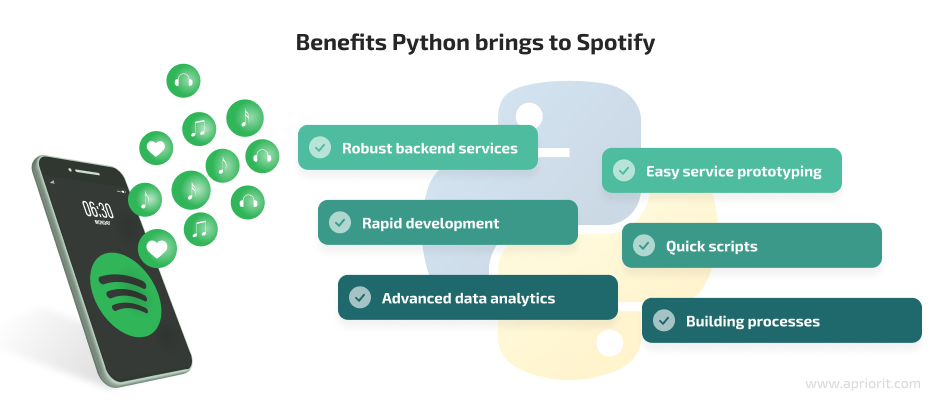
Case study:
Building an AI-based Healthcare Solution
3. Netflix
Netflix is a world-famous streaming service that offers a wide variety of TV shows, movies, documentaries, and more on thousands of internet-connected devices.
The service is so popular that in the second quarter of 2022, Netflix had approximately 220.67 million paid subscribers worldwide. The company’s reported net income in the third quarter of 2022 was around $1.4 billion (net income for Q3 2021 was roughly $1.45 billion).
As a complex high-load solution, Netflix uses a variety of frameworks, libraries, and programming languages, including Java, Node.js, JavaScript, and React. But Python has played the most significant role in developing this streaming platform.
How does Netflix leverage Python?
According to the Netflix TechBlog, engineers use Python to:
- Design, build, and operate the content delivery network infrastructure. Netflix developers also use Python in applications for device interaction and operational data collection. This language was chosen because it’s intuitive and helps developers to efficiently handle networking problems.
- Handle various in-cloud tasks. For example, Netflix engineers perform numerical analysis using NumPy and SciPy; make changes to AWS infrastructure using Boto3; run asynchronous workloads using RQ; and analyze operational data and prototype visualization tools for detecting capacity regressions using nteract.
- Improve network performance analysis and alerts. Python libraries including NumPy, SciPy, ruptures, and pandas help Netflix developers automate the analysis of thousands of related signals when their alerting systems indicate problems and parallelize large amounts of analytical work. Netflix engineers also use Python for automation tasks, data exploration, data cleaning, and data visualization.
- Enhance information security. Python helps Netflix ensure security automation, risk classification, auto-remediation, and vulnerability identification.
- Power personalization algorithms. Netflix developers use Python tools such as TensorFlow, Keras, and PyTorch for working with deep neural networks to improve their algorithms for recommendations, artwork personalization, and marketing.
Apart from that, Netflix applies Python in monitoring and auto-remediation functionalities, as well as in orchestration, notebooks, the Experimentation Platform, video encoding, and more, proving the versatility of this programming language.
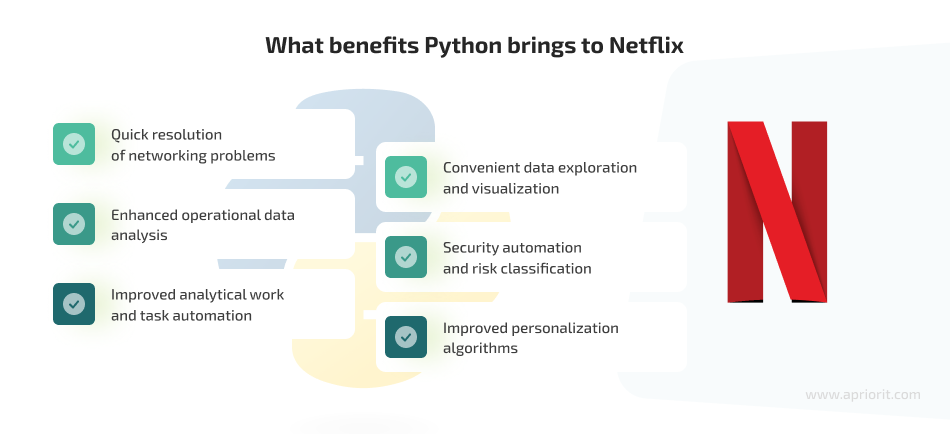
4. Facebook
Facebook is a social media and social networking service that allows users to create profiles; share information about themselves; post text, photos, and videos; and share content with other users.
This social media platform is one of the most popular; as of the second quarter of 2022, Facebook had roughly 2.93 billion monthly active users worldwide. Revenue for Meta (Facebook’s parent company) was over $117 billion in 2021, up by over $31 billion from the previous year.
While the Facebook front end is mostly written in JavaScript, the back end is powered by several languages, including Python, C++, Java, Erlang, Hack, and XHP. In 2016, Python was the most commonly used language among production engineers at Facebook. In 2022, Meta showed how important Python is to them by giving $300,000 to the Python Software Foundation, the group that maintains Core Python.
How does Facebook leverage Python?
Accounting for millions of lines of code and thousands of libraries and binaries, Python code amounts to 21% of Facebook’s codebase.
In production engineering, Facebook developers leverage Python client libraries such as Thrift to provide simple and reliable interfaces. Access to these libraries reduces the number of engineers needed to write, test, and maintain code. Thus, developers can more quickly integrate new and updated services into Facebook’s infrastructure as well as ensure the infrastructure’s reliability and scalability.
Facebook also uses Python to:
- Enhance infrastructure management. For instance, Facebook engineers use Python for managing the lifecycle of hardware, from the time it arrives in a data center to the time when it’s decommissioned.
- Develop various helpful platform services. Python powers various general-purpose services, including a scalable job scheduling and execution framework and a service for transferring large files and software packages.
- Ensure service configuration management. Python helps developers write code that dynamically generates configuration objects without having to create, maintain, or learn to use complex templating systems.
- Establish operational efficiency. Facebook developers have used Python to build MySQL Pool Scanner, a service that automatically keeps database infrastructure healthy the way a database administrator typically would. They also have used a Python tool built on top of Job Engine for phased rollouts with automatic safety checks.
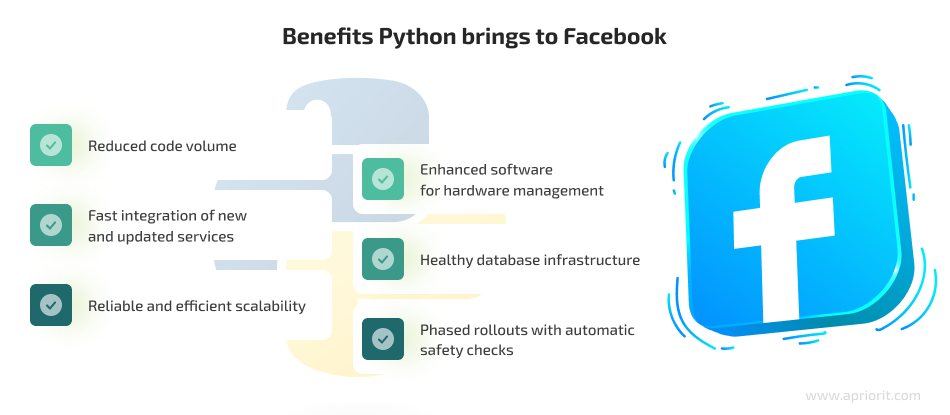
Read also:
How to Develop Smart Chatbots Using Python: Examples of Developing AI- and ML-Driven Chatbots<
5. Uber
Uber is a ridesharing company with a mobile app that allows passengers to hail a ride and allows drivers to get paid. Based in San Francisco, Uber provides mobility as a service in countries all over the world. Apart from ride-hailing, Uber also offers food delivery, package delivery, and freight transportation.
Although similar mobile transportation providers keep growing and making this market more competitive, Uber is still popular. In 2021, Uber Technologies generated around $17.5 billion in net revenue, with around 93 million monthly users all over the world.
To build the Uber platform, developers used Python, Node. js, Go, and Java.
How does Uber leverage Python?
Uber developers have benefited from Python’s ability to handle heavy math and have used this programming language for implementing functionality to predict demand and supply, surges, and expected arrival times. They use Python for routing, service discovery, creating logging functions, and managing data. Python is also applied in a web framework that connects Uber drivers and passengers.
The Uber platform handles a vast amount of data using machine learning algorithms and data analytics. When a user orders a car, Uber has to process the user’s location and credit card information, current demand, the cost of the ride, information on nearby drivers, etc. To make sure the platform can process all that data, developers use Python libraries such as NumPy, SciPy, Matplotlib, and Pandas.
They also use Python- and machine learning-powered surge pricing algorithms to analyze an area’s economy, weather, and current traffic conditions. Thus, Uber can set the most reasonable prices and position drivers efficiently, considering geolocation data and demand forecasting.
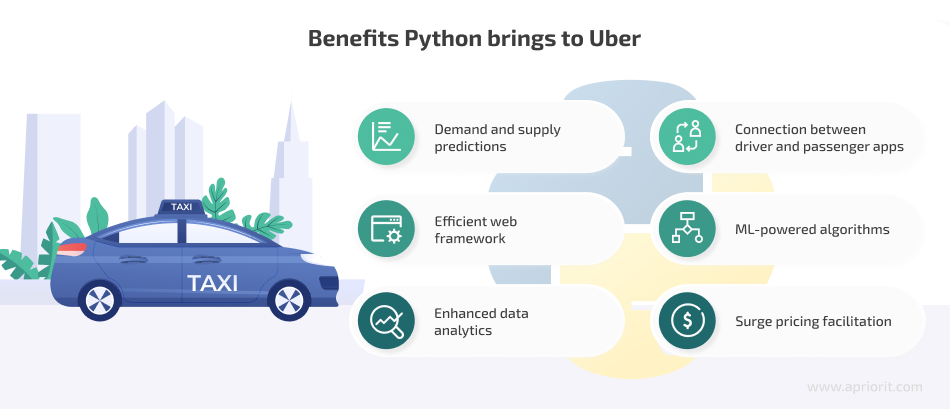
How can your project benefit from Python?
When it comes to product development, Python can power solutions for various industries and help you solve various technical tasks. Here are just a few examples of Python use cases:
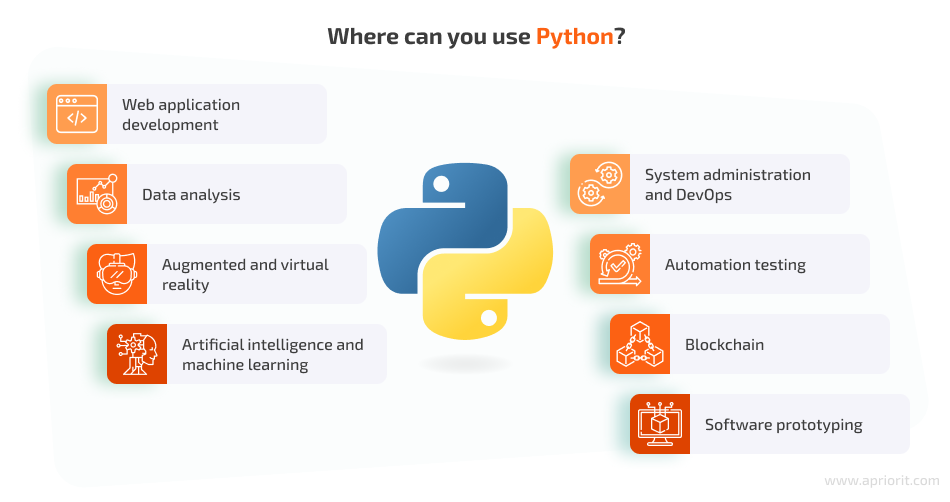
No matter what industry you work in and what tasks you want your software to solve, Python is likely to be a suitable language to improve your IT project.
When you’re only starting to build a new product, Python can help you accelerate prototype development so you can quickly prove your idea and keep expanding your project, leveraging other benefits of Python. And if you already have a solution written in another language, you can still benefit from Python by enhancing your product by integrating various third-party services.
For example, at Apriorit, we often discover new use cases for Python and leverage them to power solutions, with Python either the primary programming language or an additional one.
Here are a few examples of recent projects where Apriorit specialists have successfully leveraged Python’s potential:
- A robust AI-based system for a healthcare center that leverages Python libraries and image processing modules to ensure accurate follicle detection, segmentation, and measurement
- A decentralized blockchain application for international remittance payments that uses Python along with Go, Node.js, and React
- Windows API hooking and comparing how working with С/С++ differs from programming with Python
- Smart chatbots
- Automated GUI testing of Windows applications with Pywinauto
- Analysis of physical memory dumps using the Python-powered Volatility framework to find bugs, viruses, and malware
Feel free to contact Apriorit experts to discover how this language can enhance your project and learn more about use cases for Python.
Read also:
Anomaly Detection on Social Media: How to Build an AI-Powered SaaS Platform with Python Tools
Conclusion
Choosing Python as the main or an additional programming language for your software will help you accelerate development and enrich your software’s functionality thanks to the variety of open-source Python libraries and third-party modules.
Make sure to consult developers and business analysts as to whether Python will be the most fitting option for your particular project. At Apriorit, we have a professional team with deep expertise and rich experience in Python development. Our specialists will gladly assist you with any questions, recommend technologies that suit your project, and help you deliver a reliable and compatible IT product.
Contact us to consult Apriorit’s top-notch Python developers and start working on your IT solution right away!


